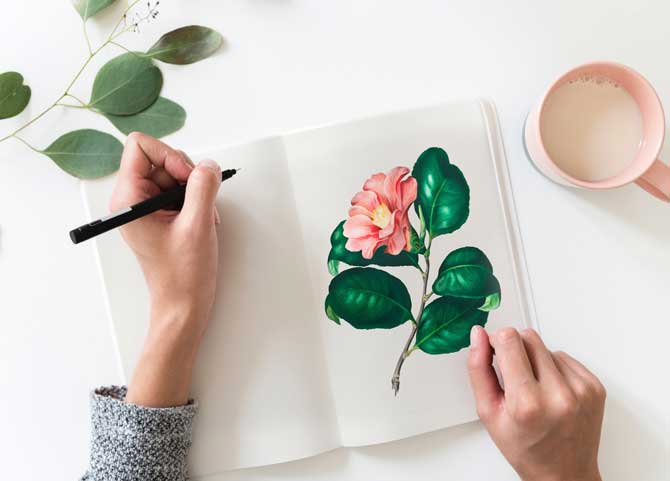Testimonials - Read the nice things people say about Classic Publishing
Creating and selling printed Greeting Cards from your own images
The big advantage of selling printed greeting cards from your own image(s) is that they are unique. The cards are unobtainable elsewhere. You can also keep selling the reproductions of the same image for many years, even after you may have sold the original work. You can gradually build up knowledge of what sells and steadily increase your range - at your own pace.
If you are an artist or a photographer, you may already have an outlet for your work. If not there are a huge range of places where your work can be sold as greeting cards.
Finding your market
It is always a good idea to take a tour of some local greeting card outlets to view other people's work and to see what is selling. In recent years, the soppy sort of greeting card, with an insincere rhyming message inside has tended to go out of fashion. The trend is now towards either cards with a funny message or for artistic cards with a photographic or artistic image. Very often these cards are plain inside which means that you have a wider market as the cards can be used for birthdays as well as for many other occasions.
The market for greeting cards is vast and shows no signs of diminishing. Despite the rise in social media and e-cards, printed greeting cards remain very popular and are sold in almost every kind of retail outlet that you can think of. This means that once you can establish a market for your greeting cards, you can have a steadily rising income for life.
Do I need a brand?
Creating a brand definitely helps your greeting cards look more professional. A thumbnail image of the front, on the reverse of the card helps to make your cards stand out from the crowd. Design a simple logo featuring your name or your trading name and make sure that it is attractive and professional looking. Remember, you can trade as anything that you like, provided that the name is not already being used in the same line of products. No-one can stop you using your own name either. Something simple like "Yourname Cards" will work.
 Where can I sell my greeting cards?
Where can I sell my greeting cards?
Just about every type of retail outlet sells greeting cards. They are incredibly popular, with many people buying at least one greeting card every week - often more. Most families buy around 88 greeting cards per annum, not including Christmas cards - a massive market worth billions. Most greeting cards are bought by women. Have a look around your local area and see who is offering greeting cards for sale. Start locally and work outwards as this makes it easier to keep the stock levels up. You can sell your greeting cards in fuel stations, public houses, garden shops, garden centres, retail stores, gift shops, florists, fancy goods outlets, boutique shops, art galleries, photo galleries, greeting card shops, antique shops - the list is endless!
What subject should I pick?
It is best to create greeting cards that appeal to you. Only you will know your target audience. Your friends and family have probably already suggested that you sell some of your images as greeting cards so ask them first which ones they think are most likely to sell. Show a few images to local shops and greeting card retailers as their opinion will be invaluable. Most greeting cards are bought by women, but of course, some of them are bought for men. This means that there is a fantastic range of subjects that will sell, from the 'chocolate-boxy' images such as kittens and flowers through to serious art. Anything from humour (sometimes crude), vintage cars, nostalgia such as railway stations or country scenes, farming, locomotives, ships or even horses may sell to men. Women buy humour, irony, photo, flowers, painting and almost everything else.
How do I get my ideas?
The best way is to get inspiration from others. Wander around some greeting card outlets and try to get an idea what seems to be selling. Don't blatantly copy any designs that appeal to you but instead allow yourself to be inspired by some of these. It is alos a good idea to market something different, to appeal to a 'niche' market or to a particular gap in the market. If you already paint, you will hopefully already have a range of images that you can turn into greeting cards. Even if you have sold the work already, many people will be delighted to let you reproduce the image as greeting cards, as this increases the perceived and often the actual value of their painting, drawing or sketch. Photographic cards are less popular than art but still have a strong following. Select subjects that appeal to you and only market your best work.
 Can I make my greeting cards at home?
Can I make my greeting cards at home?
If you have the skills and patience to make greeting cards at home there is definitely a market for hand-made cards. Some people create a stock of hand made cards, utilising the designs that they have found to be popular, while other people create custom greeting cards, to a theme chosen by the customer. It is up to you. The problem with hand-made greeting cards is that they are very labour-intensive, often taking up to 30 minutes to make. This limits how many cards you can produce and also how many cards you can sell. Many people who make embellished cards, have the basic card printed by Classic Publishing and then add 'the twiddly bits' such as miniature clothes pegs, paper flowers, standard shapes etc which can be bought quite cheaply from places such as Hobbycraft
What do I need to do to get my greeting cards printed
All you need to do to get your greeting cards printed by Classic Publishing is to choose your greeting card size, then upload the image(s) to us when you place the order. The Classic Publishing Studio do all the rest, creating the finished artwork for the greeting card(s) and emailing a PDF proof before going to print. Even better, they never ask for any payment until you are 100% satisfied with the PDF proof(s) and will re-proof until you are totally satisfied.
Remember, Classic Publishingdo not charge for artwork layout, proofing, re-proofing, white 100gsm gummed diamond flap envelopes or safe and secure next-day carrier delivery.
Where do I start to sell my images as greeting cards?
Take the plunge. Make or order a small sample of your favourite design, and see how they sell locally. Make sure that your greeting cards are printed professionally as cards from your home ink-jet printer will not look very professional. Packing your greeting cards with the envelope in 'cello' bags is always a good idea as it keeps the stock clean and easier to sell. High quality diamond-flap heavy-weight white envelopes are free with greeting cards ordered from Classic Publishing.
 Greeting Cards Quality
Greeting Cards Quality
It is vitally important that your greeting cards are good quality, printed professionally and presented properly. Your sales outlets will be used to receiving cards that are well produced and that sell well. Take care that you have chosen a size that fits onto the racks that your retailers use. The most popular sizes are 140mm square and 5" x 7" in portrait or landscape format.
Read more about Printed Greeting Cards
Decide on the type of cards you wish to create
Unique cards will always sell, especially if they are aimed at a local market. Views of Cornish Cliffs will sell well in Cornish holiday shops, but not too well in Edinburgh! Attractive images or paintings of remote Scottish landcapes will sell well in Scottish tourist shops and so on. Greeting cards with embellishments are still popular, especially if a little quirky or unusual. Vintage black and white photographs (which you could always recreate with your own models) that have a funny caption sell well. Greeting cards with scrapbook-like decorations are popular, so look for inexpensive items that can be added to your designs to increase the perceived value. Mulberry paper is an attractive hand-made paper that leaves a lovely soft edge when torn. Make some mulberry paper embellishments for your cards or incorporate ready-made cut-out shapes that you can buy cheaply via Ebay™ or Amazon™
Greeting card embellishments are available from a wide range of retailers and from Ebay™. Hobbycraft carry a large range as well. Embellishing your greeting cards can make them stand out from the rest. The only downside to adding items to the front of your greeting cards is that it may make the envelope over 5mm thick. If this is the case, then the card will have to be posted as a 'Large Letter' which costs more.
People love a hand-made card because they have a hand-made feel that makes the recipient feel that the giver has chosen the card just for them. Only you can decide on what type of greeting cards to specialise in.
Testing your product
It is a good idea to only make or buy in a fairly small quantity of greeting cards to start with. This is one advantage of buying from Classic Publishing as you can order from as few as 20 printed cards. Obviously, once your card range is successful you will order in larger quantities and get the benefit of much lower prices - with higher profits. To test your greeting cards, ask a local shop to stock the cards and ask them to report back on customer comments and how they sell. A good investment may be to give a few saleable greeting cards to the shop in return for their help.
Set up a stall at a local craft fair. Pay attention to how people respond to your cards and take note of their opinions. Ask the advice of other greeting card sellers. Most people are very helpful to a newcomer.
Create a social media presence. Many people have started out in the greeting card business by starting a social media presence. Initially you may just sell a few cards to your friends and family, but as news of your products grow, sales will increase. In this day and age it is very important to market yourself online so make sure that you have a website, however simple. A fun and catchy name helps as well, especially for your website and for your Facebook page. Ask friends who you think may be interested in your cards and ask them to spread the word amongst their friends and contacts. It pays to get your name out there.
Selling your greeting cards online
Especially if your greeting cards are out of the ordinary, you should be selling your cards online. You can either establish your own ecommerce website with someone like Wix or you can sell your cards on Amazon, Ebay or Etsy. You can market individual cards or sell in packs of six, with perhaps assorted designs on the same theme. Many people find that it is easier to sell online than face to face, although nothing beats having your cards for sale locally in a range of retail outlets.
What should I charge?
As people only buy birthday greeting cards in small quantities, they are not as price-conscious as when buying larger amounts, such as Christmas cards. This means that if the card attracts them they will be happy to pay your price, up to say £3.50. This can be more if you are selling direct to the customer online via Etsys or similar. With trade sales however, please bear in mind that the greeting card retailer is going to want to double their money. This is the standard mark-up in the greeting card trade. So if you sell a batch of greeting cards to a retailer for £1 each, they are going to want to retail at £2 plus the VAT. In practice this will price the card to the public at £2.20 or even more. However, it is a very nice feeling to buy a batch of cards at around 20p each and sell them wholesale at £1 each. Initially, it is also a good idea to offer your cards on sale or return to the retailer so that they have no risk. Make sure that your cards are packed in glass-clear 'cello' bags to keep the stock clean, then if any particular cards do not sell in one outlet, you can try them in another.
| Read more about Printed Greeting Cards |